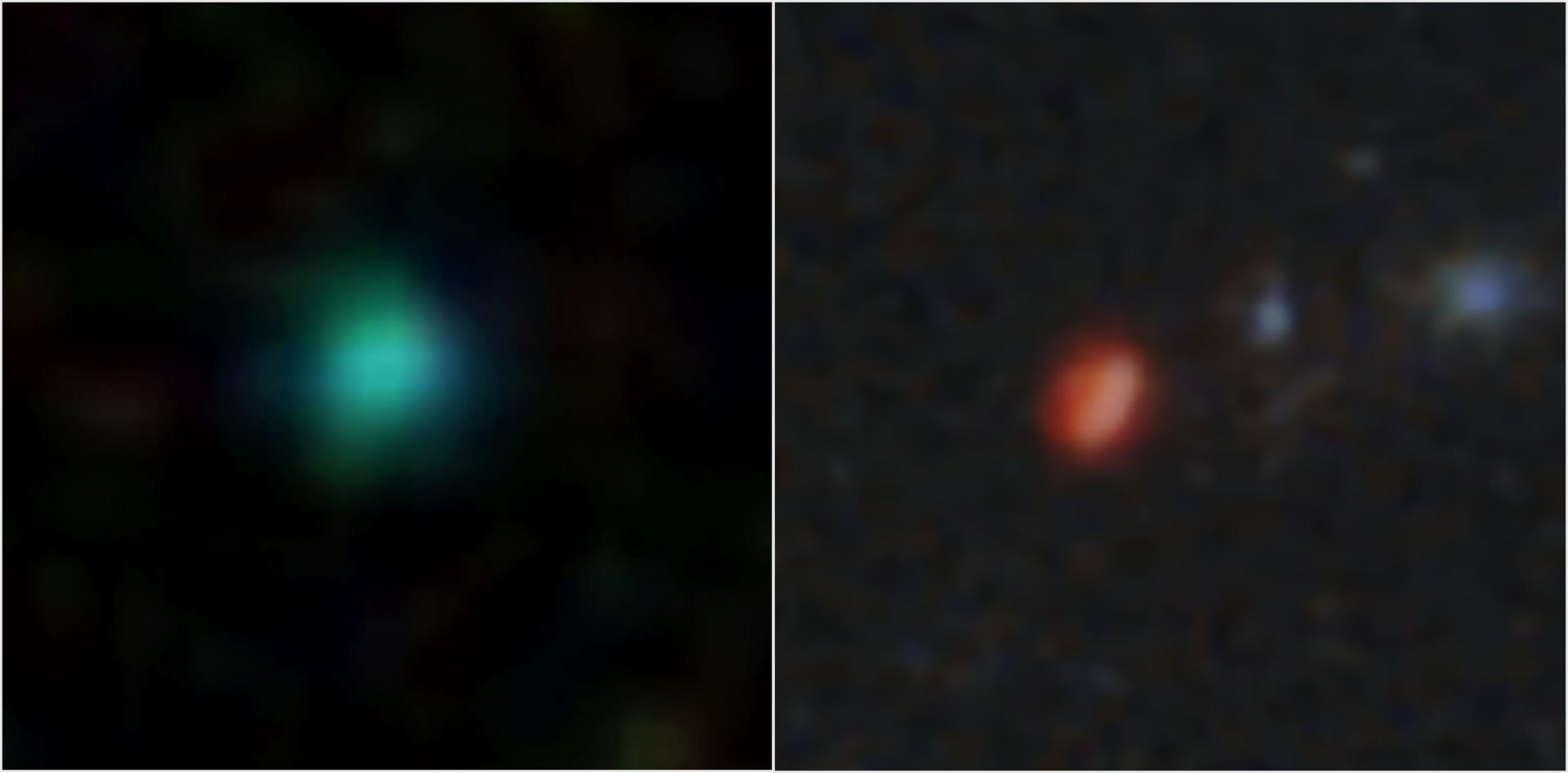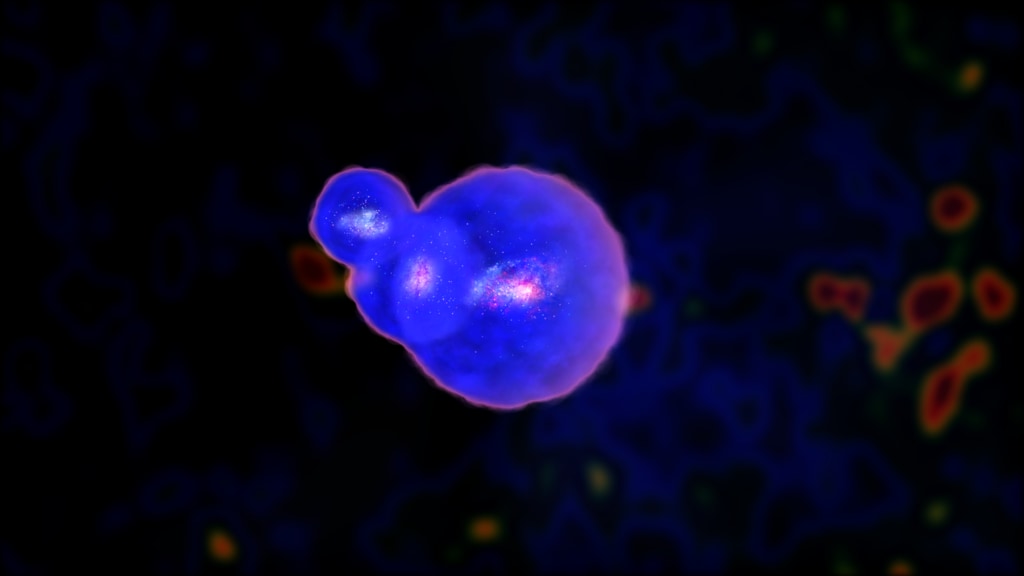NASA’s Webb Reveals Galaxy Population Driving Cosmic Renovation

Symbols mark the locations of young, low-mass galaxies bursting with new stars when the universe was about 800 million years old. Using a filter sensitive to such galaxies, NASA’s James Webb Space Telescope imaged them with the help of a natural gravitational lens created by the massive galaxy cluster Abell 2744. In all, 83 young galaxies were found, but only the 20 shown here (white diamonds) were selected for deeper study. The inset zooms into one of the galaxies.
Credit: NASA/ESA/CSA/Bezanson et al. 2024 and Wold et al. 2025
Alt text: Animation showing the locations of young, low-mass, starburst galaxies around galaxy cluster Abell 2744.
Image description:
White and yellow galaxies of various sizes and shapes appear against the blackness of space. Two bright stars in our own galaxy display prominent six-spike diffraction patterns with bluish rays, visible at center left and lower left. Then 20 white diamonds sweep across the image. One diamond enlarges to reveal an image of a young, low-mass, star-forming galaxy. It looks like a green oval against a red and green checked background. The enlarged image then shrinks back, and the diamonds sweep away. The sequence loops.
Astronomers using data from NASA's James Webb Space Telescope have identified dozens of small galaxies that played a starring role in a cosmic makeover that transformed the early universe into the one we know today. These tiny but mighty galaxies have both the ultraviolet power and the numbers to drive this cosmic renovation.
The study took advantage of existing imaging collected by Webb's NIRCam (Near-Infrared Camera) instrument, as well as new observations made with its NIRSpec (Near-Infrared Spectrograph) instrument. Astronomers found the galaxies by sifting through Webb images captured as part of the UNCOVER (Ultradeep NIRSpec and NIRCam ObserVations before the Epoch of Reionization) observing program, led by Rachel Bezanson at the University of Pittsburgh in Pennsylvania.
The project mapped a giant galaxy cluster known as Abell 2744, nicknamed Pandora's cluster, located about 4 billion light-years away in the southern constellation Sculptor. The cluster's mass forms a gravitational lens that magnifies distant sources, adding to Webb's already considerable reach.
For much of its first billion years, the universe was immersed in a fog of neutral hydrogen gas. Today, this gas is ionized — stripped of its electrons. Astronomers, who refer to this transformation as reionization, have long wondered which types of objects were most responsible: big galaxies, small galaxies, or supermassive black holes in active galaxies. As one of its main goals, NASA's Webb was specifically designed to address key questions about this major transition in the history of the universe.
Recent studies have shown that small galaxies undergoing vigorous star formation could have played an outsized role. Such galaxies are rare today, making up only about 1% of those around us. But they were abundant when the universe was about 800 million years old, an epoch astronomers refer to as redshift 7, when reionization was well underway.
The team searched for small galaxies of the right cosmic age that showed signs of extreme star formation, called starbursts, in NIRCam images of the cluster. Such low-mass galaxies gather less neutral hydrogen gas around them, which makes it easier for ionizing ultraviolet light to escape. And starburst episodes produce plentiful ultraviolet light that carves channels into a galaxy's interstellar matter that also helps the light break out.
The astronomers looked for strong sources of a green line emitted by oxygen atoms that have lost two electrons. Originally emitted as visible light in the early cosmos, the green glow from doubly ionized oxygen was stretched into the infrared as it traversed the expanding universe and eventually reached Webb's instruments.
This technique revealed 83 small starburst galaxies as they appear when the universe was 800 million years old, or about 6% of its current age of 13.8 billion years. The team selected 20 of these for deeper inspection using NIRSpec. The galaxies are so small that building the equivalent stellar mass of our own Milky Way galaxy would require from 2,000 to 200,000 of them.
Similar galaxies in the present-day universe, such as green peas, release about 25% of their ionizing ultraviolet light into surrounding space. If these low-mass starburst galaxies release a similar amount, they can account for all of the ultraviolet light needed to convert the universes neutral hydrogen to its ionized form.

One of the most interesting galaxies of the study, dubbed 41028 (the green oval at center), has an estimated stellar mass of just 2 million Suns — comparable to the masses of the largest star clusters in our own Milky Way galaxy.
Credit: NASA/ESA/CSA/Bezanson et al. 2024 and Wold et al. 2025
Alt text: Enlarged view of a single young starburst galaxy.
Image description:
A pixelated green oval extending from upper left to lower right sits in the middle of a red and green checked background. A large white blob is visible at center right.

At left is an enlarged infrared view of galaxy cluster Abell 2744 with three young, star-forming galaxies highlighted by green diamonds. The center column shows close-ups of each galaxy, along with their designations, the amount of magnification provided by the cluster’s gravitational lens, their redshifts (shown as z — all correspond to a cosmic age of about 790 million years), and their estimated mass of stars. At right, measurements from NASA’s James Webb Space Telescope’s NIRSpec instrument confirm that the galaxies produce strong emission in the light of doubly ionized oxygen (green bars), indicating vigorous star formation is taking place.
Credit: NASA/ESA/CSA/Bezanson et al. 2024 and Wold et al. 2025
Alt text: Close-up of Abell 2744 showing detailed information on three young starburst galaxies.
Image description:
Three columns of images and information appear on a black background. At left is an infrared image showing white and yellow galaxies of various shapes and sizes, with three green diamonds superimposed on it. Light gray shading extends from each diamond to a square image in the center column. The top image is labeled 41038, the middle one is 41028, and at bottom is 41006. Each image shows a green blob on a red and green checked background, while the middle and bottom images include a large white blob as well. Next to each image is textual information. For the top image, it reads “Magnified 13 X, z = 6.8690, Stellar mass 10 million Suns”; for the middle image, “Magnified 11 X, z = 6.8697, Stellar mass 2 million Suns”; for the bottom image, “Magnified 3 X, z= 6.8717, Stellar mass 160 million Suns.” At right is a column of line graphs and colored bars representing a spectrum of each galaxy. The colored bars align with peaks in a squiggly line running horizontally across each graph. There is one blue bar, labelled “Hydrogen,” and two green bars, labeled “Oxygen,” in each graph. The vertical axis of the graphs reads “Brightness,” while the horizontal axis reads “Wavelength (µm),” with numbers ranging from 3.82 to 3.94.

This Webb composite of galaxy cluster Abell 2744 incorporates images taken through three NIRCam filters (F200W as blue, F410M as green, and F444W as red). The F410M filter is highly sensitive to light emitted by doubly ionized oxygen oxygen atoms that have been stripped of two electrons at a time when reionization was well underway. Emitted as green light, the glow was stretched into the infrared as it traversed the expanding universe over billions of years. The cluster’s mass acts as a natural magnifying glass, allowing astronomers to see these tiny galaxies as they were when the universe was about 800 million years old.
Credit: NASA/ESA/CSA/Bezanson et al. 2024 and Wold et al. 2025
Alt text: Composite Webb NIRCam image of galaxy cluster Abell 2744
Image description:
White and yellow galaxies of various sizes and shapes appear against the blackness of space. Two bright stars in our own galaxy display prominent six-spike diffraction patterns with bluish rays, visible at center left and lower left.

White diamonds show the locations of 20 of the 83 young, low-mass, starburst galaxies found in infrared images of the giant galaxy cluster Abell 2744. This composite incorporates images taken through three NIRCam filters (F200W as blue, F410M as green, and F444W as red). The F410M filter is highly sensitive to light emitted by doubly ionized oxygen — oxygen atoms that have been stripped of two electrons — at a time when reionization was well underway. Emitted as green light, the glow was stretched into the infrared as it traversed the expanding universe over billions of years. The cluster’s mass acts as a natural magnifying glass, allowing astronomers to see these tiny galaxies as they were when the universe was about 800 million years old.
Credit: NASA/ESA/CSA/Bezanson et al. 2024 and Wold et al. 2025
Alt text: Composite Webb NIRCam image of galaxy cluster Abell 2744, showing the locations of young starburst galaxies.
Image description:
White and yellow galaxies of various sizes and shapes appear against the blackness of space. Two bright stars in our own galaxy display prominent six-spike diffraction patterns with bluish rays, visible at center left and lower left. Superimposed on the infrared image are 20 white diamonds, each representing a young galaxy investigated in greater detail.

As above, but with no white boxes and three young, low-mass, star-forming galaxies highlighted by green boxes. The middle box encloses the galaxy dubbed 41028.
Credit: NASA/ESA/CSA/Bezanson et al. 2024 and Wold et al. 2025
Alt text: Webb composite of Abell 2744 showing the locations of three young starburst galaxies.
Image description: White and yellow galaxies of various sizes and shapes appear against the blackness of space. Two bright stars in our own galaxy display prominent six-spike diffraction patterns with bluish rays, visible at center left and lower left. Superimposed on the infrared image are, at right, three green diamonds, each representing a young galaxy investigated in greater detail.
For More Information
See NASA.gov
Credits
Please give credit for this item to:
NASA's Goddard Space Flight Center. However, individual items should be credited as indicated above.
-
Science writer
- Francis Reddy (University of Maryland College Park)
-
Scientists
- James Rhoads (NASA/GSFC)
- Sangeeta Malhotra (NASA/GSFC)
- Isak Wold (Catholic University of America)
Missions
This page is related to the following missions:Release date
This page was originally published on Wednesday, June 11, 2025.
This page was last updated on Tuesday, June 10, 2025 at 12:51 PM EDT.

